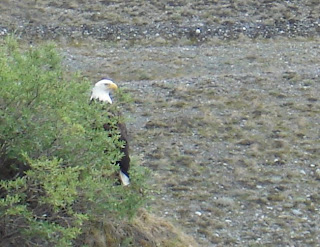 It’s a rainy Saturday in Valdez, so we’re not sightseeing today. Therefore, it’s a good time to update the travel journal, particularly since once we leave here tomorrow we’re not sure when or where we’ll have internet access.
It’s a rainy Saturday in Valdez, so we’re not sightseeing today. Therefore, it’s a good time to update the travel journal, particularly since once we leave here tomorrow we’re not sure when or where we’ll have internet access.Wednesday morning we packed up and left Kenny Lake for the Richardson Highway to Valdez, about 80 miles south. The Richardson Highway was Alaska’s first road, built as the ‘Valdez to Eagle Trail’ by gold seekers in 1898. It was upgraded to a road in 1920 and first paved in 1957. It was cloudy and rainy along the way, so we didn’t stop at Worthington Glacier or several beautiful waterfalls along the way. As we crossed Thompson Pass, about 2,800 feet high, we saw quite a bit of fresh snow on the mountains. It doesn’t take much elevation to have snow up here, particularly since summer seems to have abandoned much of the state.
Valdez, pronounced “Val-Deez”, is a town of about 4,000 people. The town was destroyed in the 1964 earthquake and tsunami, and has been rebuilt about two miles from the original town site. Valdez is the southern terminus of the 800 mile long Alaska pipeline.

The oil shipping terminal was built in Valdez because it is the northernmost ice-free port in Alaska, making it the shortest distance from the Prudhoe Bay oil fields. In 1989, the Exxon Valdez loaded 1.5 million barrels of oil at the terminal and headed out, hitting Bligh reef, about 12 miles southeast, spilling 800,000 gallons of oil into the sound. Due to currents and wind, none of the oil reached the Valdez area.
Once settled in our campsites on the channel leading from the small boat harbor to the Valdez Arm of Prince William Sound, it was laundry time for the gals, and time to pick up the mail for the guys. On Thursday, we drove to the other side of the arm, toward the oil terminal. No visitors have been allowed on the terminal grounds since 9/11/01 for security reasons.
 We were able to get to the gate for photos, as well as visit a salmon fish hatchery on the way. A large run of pink or “humpy” salmon were struggling to get up the stream and the hatchery fish ladder. There were so many salmon that they totally filled the area.
We were able to get to the gate for photos, as well as visit a salmon fish hatchery on the way. A large run of pink or “humpy” salmon were struggling to get up the stream and the hatchery fish ladder. There were so many salmon that they totally filled the area. A short distance down the road from the hatchery, we observed a female black bear catching fish for herself and her nearby cubs. We didn’t see the cubs, but other bear-watchers said there were three of them. Neat!
A short distance down the road from the hatchery, we observed a female black bear catching fish for herself and her nearby cubs. We didn’t see the cubs, but other bear-watchers said there were three of them. Neat!
On Friday, Debbie & Tom took a glacier tour on the Lu-Lu Belle, a 75 foot cruiser owned and operated by her skipper, Fred, for over 30 years. The boat was luxurious, with teak and mahogany trim and oriental rugs on the floors. Fred built the boat himself, and conducts all tours himself. He’s a great talker, and goes ‘the extra mile’ for his passengers. Just out of the harbor, we spotted a large number of sea otters. We traveled to Glacier Island, where we saw a number of eagles, puffin, sea lions, and humpback whales.


From there, we headed into Columbia Bay and the Columbia Glacier, the third largest glacier in Alaska. The glacier was stable, that is, not advancing or retreating, over the past 200 years, then in 1984, a large void formed behind the front of the glacier.
 That void filled with sea water, and the glacier front broke apart. The present head of the glacier is now about seven miles behind the previous head.
That void filled with sea water, and the glacier front broke apart. The present head of the glacier is now about seven miles behind the previous head.  Much of the ice that broke off is still in the immediate area, in the form of icebergs. Captain Fred took us way into this ice field and back out, a careful journey that took well over two hours. A most impressive cruise, indeed.
Much of the ice that broke off is still in the immediate area, in the form of icebergs. Captain Fred took us way into this ice field and back out, a careful journey that took well over two hours. A most impressive cruise, indeed.


































